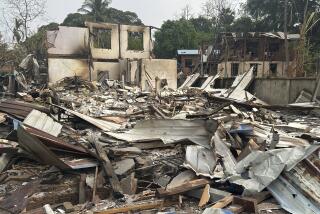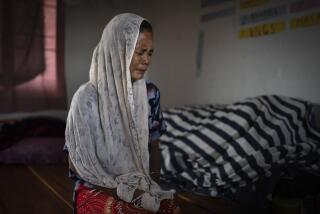Indian Troops Step Up Efforts to Halt Conflict in Sri Lanka
- Share via
COLOMBO, Sri Lanka — Reinforced Indian troops, stepping up their peacekeeping role in the Sri Lankan ethnic conflict, set up roadblocks and arrested several Tamil guerrillas Thursday as violence continued to mount in the volatile Eastern province of this island nation.
Twelve people, including a popular Tamil government agent from Batticaloa, the provincial capital, were killed in a precisely timed, remote-controlled explosion Thursday morning. Tamil separatist guerrillas killed at least seven Sri Lankan soldiers in three other incidents Thursday, raising the death toll since Monday to more than 200.
The 12,000 Indian army soldiers and paramilitary personnel on the island were ordered for the first time Thursday to “shoot to kill” in any conflict with the militant separatists. On instructions from Prime Minister Rajiv Gandhi, the Indian army chief of staff, Krishnaswami Sunderji, toured Indian positions in the disputed northern and eastern regions of the island.
India’s ambassador to Sri Lanka, J. N. Dixit, reported that “five or six” Tamil guerrillas had been arrested Thursday in the east as part of the more aggressive Indian posture here. Those arrested reportedly included at least one regional commander of the Liberation Tigers of Tamil Eelam, the largest and most powerful of the Tamil rebel groups.
Denies Leader Arrested
It was widely rumored that Tamil Tiger leader Vilupillai Prabakaran had been arrested, but Dixit denied it. Prabakaran reportedly makes his base in the Tamil stronghold of Jaffna on the extreme northern tip of the island.
Officials said they feared that the arrest of Prabakaran would spark bloody reprisals by Tamil rebels against the Sinhalese civilian population similar to attacks that erupted earlier this week. The reprisals came after 12 Tigers were arrested and then committed suicide by swallowing cyanide capsules. The cyanide capsules, worn strung around the neck, are a trademark of the Tiger fighters.
Indian officials say the latest violence, which threatens to shatter a July 29 peace agreement negotiated by the Indian government, can be attributed to the Liberation Tigers’ anger over the suicides.
The worst incident Thursday occurred seven miles outside Batticaloa near Komanthurai when a car carrying government officials, escorted by two Indian army vehicles, was blown up. Its 10 occupants and two civilians were killed.
Respected Official Killed
Among the dead was Marianpillai Anthonimuthu, a respected government agent in Batticaloa for the last several years. Anthonimuthu, a Tamil, was a civil servant who remained loyal to the government despite nearly constant threats on his life by militant Tamil factions.
Two years ago, he was warned by Tamil guerrillas that he would be killed if he raised the Sri Lankan flag over the Batticaloa government complex. To protect members of his staff against possible violence, Anthonimuthu dismissed them and raised the flag himself. Gradually, he appeared to win the respect of all factions in the community.
Thursday morning, he was in a vehicle sandwiched between two Indian army jeeps when attackers believed to be Tamil Tigers set off a land mine buried near the road, killing him and the nine other passengers as well as two bicyclists.
The attack was timed to avoid killing Indian troops. The convoy was moving in fairly close formation at about 40 m.p.h., witnesses said, when the mine exploded, destroying the Sri Lankan vehicle but not damaging the Indian jeeps.
Seeking Tamil Homeland
For nearly five years the Tigers have led a guerrilla movement seeking an independent homeland (Eelam) for the Tamil minority population, battling Sri Lankan government forces dominated by the majority Sinhalese population.
Tamils, the majority of whom are Hindu, account for approximately 18%, and the Sinhalese, predominantly Buddhist, for about 73% of the island’s 16 million people.
The July 29 peace agreement, hailed as a diplomatic triumph for India, brought nearly two months of peace to the Northern and Eastern provinces where most of the violence has been concentrated.
Under the agreement, signed by Indian Prime Minister Gandhi and Sri Lanka’s President Junius R. Jayewardene, a peacekeeping force of Indian troops came to the island in early August, and Sri Lankan troops were withdrawn from Tamil-dominated areas. The peace was disrupted in September when several Tamil fighting groups, including the Tigers, refused to surrender their weapons and instead attacked rival groups.
Indian officials say that some Sri Lankan Sinhalese police personnel, opposed to the agreement, attacked Indian forces in an attempt to provoke them against the civilian population.
Fragile Accord Threatened
From the beginning, the fragile accord has been threatened by elements on both sides. Among the Tamils, the main opposition has come from the young, mostly lower-caste and illiterate fighting groups who see little role for themselves in any political arrangements that might follow peace.
“All they know how to do is fight and kill,” an Indian official said recently in New Delhi.
On the Sinhalese side, the opposition has come mainly from chauvinist elements, including Buddhist priests, who oppose granting any concessions to the Tamils. The agreement calls for the establishment of a semiautonomous, majority-Tamil province connecting Northern and Eastern provinces, where the Tamils are in the majority.
Adding to the tension is an increasingly active former leftist organization, the Janatha Vikmuthi Peramuna, which has taken up the cause of Sinhalese nationalism. Since the peace agreement was signed, this organization has been blamed for 20 political assassinations and an attack on the Sri Lankan Parliament.
The organization’s activities have been concentrated in the central highlands of the island, where posters have begun to appear urging Sinhalese to kill Tamils and Indians.
More to Read
Sign up for Essential California
The most important California stories and recommendations in your inbox every morning.
You may occasionally receive promotional content from the Los Angeles Times.













